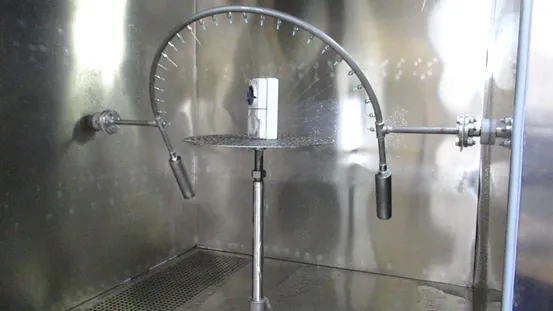ISO 16750 4 Ingress Protection Testing for Automotive Electronics
The ISO 16750 series is a comprehensive set of standards that provides guidance on the environmental conditions and test methods applicable to automotive electronics. Specifically, ISO 16750-4:2013 focuses on Ingress Protection (IP) testing for automotive electrical/electronic components. This standard ensures that vehicles can withstand harsh environmental conditions during their operational lifetime, protecting critical systems from dust and water ingress.
Ingress protection is crucial in the automotive industry because it directly impacts vehicle safety, reliability, and performance. Automotive electronics are exposed to various environmental factors such as road salt, road debris, rain, snow, humidity, and temperature variations. These elements can lead to component failure if not properly protected. By adhering to ISO 16750-4 standards, manufacturers ensure that their products meet the necessary durability and protection levels required for automotive applications.
The standard outlines specific tests designed to assess the ability of components to withstand water ingress (IPX ratings) and dust ingress (IPY ratings). For instance, IPX2 means the device can be splashed by water from any direction without being adversely affected. Similarly, an IP67 rating indicates that a component is fully protected against dust and can operate while submerged in up to 1 meter of water for at least 30 minutes.
Understanding these ratings helps quality managers and compliance officers ensure their products meet the necessary standards. R&D engineers benefit from this knowledge as they design components with appropriate IP ratings, ensuring both functionality and safety under diverse environmental conditions. For procurement teams, knowing which tests are required allows them to source suppliers who comply with ISO 16750-4.
The testing process typically involves preparing the specimen by cleaning it according to specified procedures, ensuring that there is no dust or dirt present prior to the test. Once prepared, the specimen undergoes various environmental exposures designed to simulate real-world conditions. Instruments such as spray chambers, temperature chambers, and humidity cabinets are used to apply the appropriate test parameters.
After completing each exposure period, engineers inspect the specimens for any signs of damage or failure due to water or dust ingress. Reporting includes detailed records of all tests conducted along with observations on performance and compliance with specified IP ratings.
The standard also emphasizes the importance of using correct terminology when discussing IP ratings. Terms like "dust tight" (IP65) vs. "limited protection against solid objects larger than 1mm" (IP32) are critical for accurate communication between stakeholders involved in automotive electronics development and manufacturing processes.
By complying with ISO 16750-4, manufacturers demonstrate their commitment to producing reliable products that can withstand the rigors of everyday use. This not only enhances consumer trust but also contributes significantly towards meeting regulatory requirements across different markets.
Applied Standards
| Standard Number | Description |
|---|---|
| ISO 16750-4:2013 | Ingress Protection Testing for Automotive Electrical/ Electronic Components |
| IEC 60529:2016 | Degrees of protection provided by enclosures |
| ASTM G173-18 | Determination of Water Resistance of Solar Photovoltaic Modules |
The application of ISO 16750-4 is particularly relevant in the automotive sector where environmental robustness is paramount. This standard aligns closely with other international standards like IEC 60529, which specifies degrees of protection provided by enclosures, and ASTM G173, which deals with water resistance testing for solar photovoltaic modules.
These standards collectively ensure that automotive electronics are not only robust enough to survive rigorous environmental conditions but also meet global regulatory expectations. By following these guidelines during production, manufacturers can guarantee consistent quality and reliability in their products.
Quality and Reliability Assurance
- Compliance with ISO 16750-4 ensures that automotive electronics meet the required IP ratings for dust and water ingress protection.
- Testing according to this standard helps prevent failures caused by environmental factors, thereby enhancing overall product reliability.
- Achieving compliance indicates adherence to best practices in quality assurance, which is essential for maintaining high standards within the industry.
The rigorous nature of ISO 16750-4 promotes a culture of continuous improvement among manufacturers. It encourages them to identify potential weaknesses early on and address these issues before they become critical problems. This proactive approach not only improves product performance but also reduces warranty claims and recalls, ultimately leading to higher customer satisfaction.
Moreover, by adhering to this standard, companies can demonstrate their commitment to excellence in quality management systems (QMS). This is particularly important given the increasing complexity of automotive systems that rely heavily on electronic components. Ensuring that these parts are robust against environmental challenges forms an integral part of maintaining a QMS.
For compliance officers and R&D engineers, familiarity with ISO 16750-4 provides valuable insights into how to design products that will stand the test of time in diverse operational environments. It serves as a benchmark for setting internal standards within organizations while also serving as a reference point when engaging with regulatory bodies.
International Acceptance and Recognition
- The standard is widely accepted across automotive manufacturers worldwide, ensuring consistency in testing methodologies globally.
- Compliance with ISO 16750-4 is recognized by major regulatory bodies such as the National Highway Traffic Safety Administration (NHTSA) and European Union Type Approval Authorities.
The global acceptance of this standard underscores its significance in ensuring that automotive electronics meet stringent quality and reliability benchmarks. Its recognition by key regulatory authorities further enhances its credibility, making it a preferred choice for manufacturers looking to ensure their products comply with international standards.
This widespread adoption fosters collaboration between countries, promoting the exchange of best practices in testing methodologies. It also facilitates smoother trade between nations involved in automotive manufacturing and supply chains. Manufacturers who follow this standard can expect easier market access in regions that have adopted it as part of their regulatory framework.
The recognition by major regulatory bodies adds another layer of assurance for both manufacturers and consumers alike, knowing that products tested against these criteria are held to a high level of scrutiny before being brought into the marketplace. This transparency builds trust between stakeholders involved in the automotive industry ecosystem.





